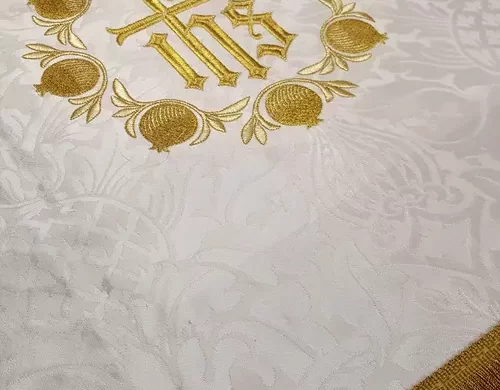
Ecclesiastical Sewing introduced a design collection entitled Dayspring. The collection features timeless and elegant designs created by our liturgical artist friend, Edward Riojas. The collection features a variety of design themes that symbolize both the Nativity of Christ and His Resurrection. The designs were gold threads stitched on white paraments and vestments, featuring designs like the IHC monogram with a rising sun, the Pomegranate design, and several others found in our various collections.
Like this:
Like Loading...

If your travel plans include a visit to Minnesota, this is an Ecclesiastical Arts Needlework Collection worth seeing. Many of the pieces in the collection are becoming fragile with age, and so, this may be the last exhibit for some of the pieces in the collection. The rose copes shown in the above photo are embroidered on a lovely white silk ground fabric. The piece is close to 100 years old or more.
Like this:
Like Loading...
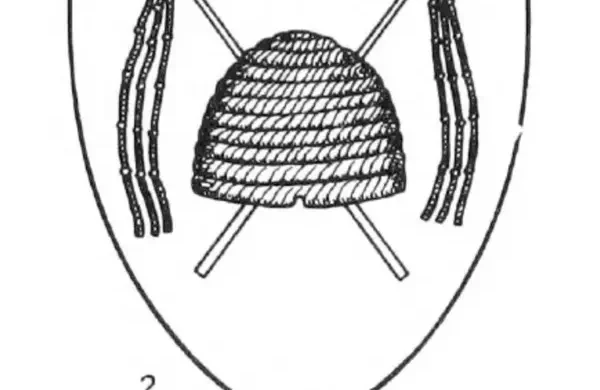
Born as Aurelius Ambrosius in 334 A.D., the man we know as St. Ambrose grew up in Gaul where his father held a high post as prefecture. It is said that a swarm of bees visited the infant Ambrose, landing upon his eyes and lips. This tradition claims to be the source of Ambrose’s ability later in life to speak in honeyed, caring words. So, the beehive has become the symbol most frequently associated with St. Ambrose because it is a symbol of eloquence. The symbol for St. Ambrose relate to the ex-communication of Emperor Theodosius for his massacre of the people of Thessalonica.
Like this:
Like Loading...
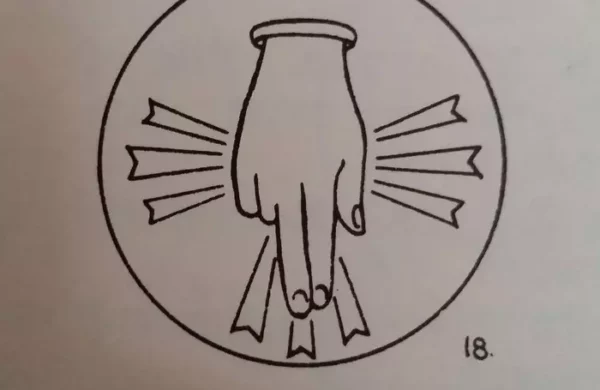
Each renowned saint has his or her own symbol in ecclesiastical sewing. A church that is named after a blessed saint can place that saint’s symbol on a piece of ecclesiastical vestment. All Saints Day, is the celebration of all of the Christian saints. During the mass persecutions, saints were martyred and there was no way to keep track of them all and mark each day as their own saint’s day. And so All Saints Day is the day we remember them. We decorate our churches in white, which reminds the feasting eyes of the congregation of the triumph of the saints, washed of their sins and made as white as snow by the all-availing sacrifice of Christ Our Saviour.
Like this:
Like Loading...
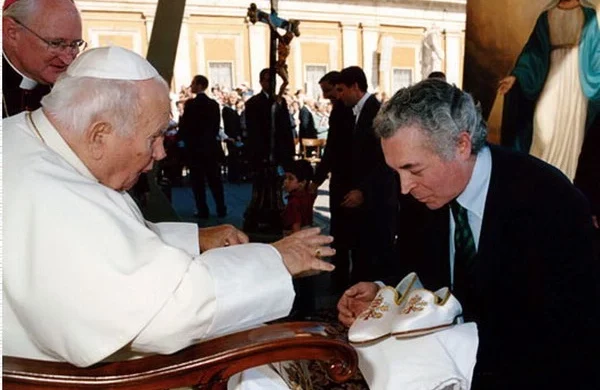
Ecclesiastical Footwear? C0113517921/[/embed] One can only imagine the honor of making a special pair of shoes for the Pope. These truly are a work of art. I hope you have… Read more Ecclesiastical Footwear? →
Like this:
Like Loading...
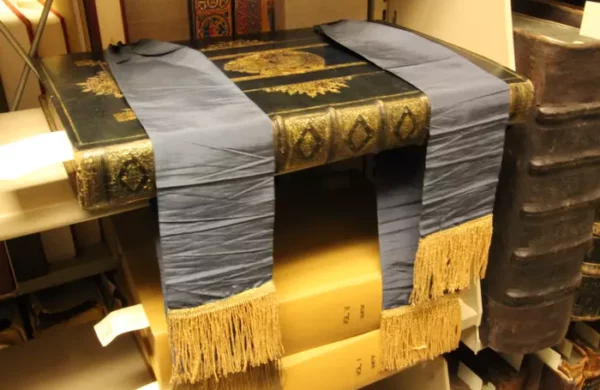
This Book of Prayer is a part of the Collection of Rare Books at the Concordia Seminary Library on the LC-MS Seminary Campus in St. Louis, MO. The Rare Books Library houses a unique collection of rare volumes relating to Church History, specifically, Lutheran Church History
Like this:
Like Loading...
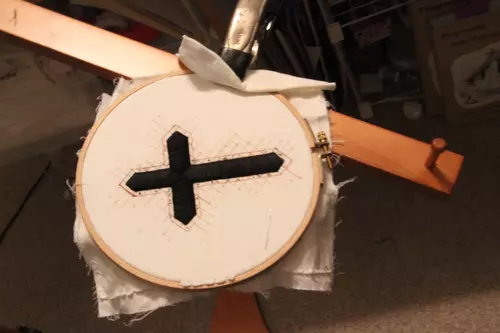
The stitching on hand embroidery project is not overly difficult. This would make a great beginner’s project with a few modifications, such as using floss padding, and a single strand of embroidery floss for the laid stitching.
Like this:
Like Loading...
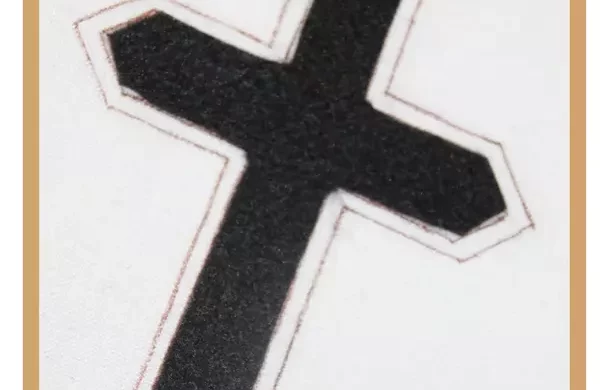
The Passion Cross has black felt padding, over which Au Ver A Soie, Soie Ovale is being stitched. A base of silk threads would be laid to create a padded surface, and then begin the stitching over thread padding.
Like this:
Like Loading...
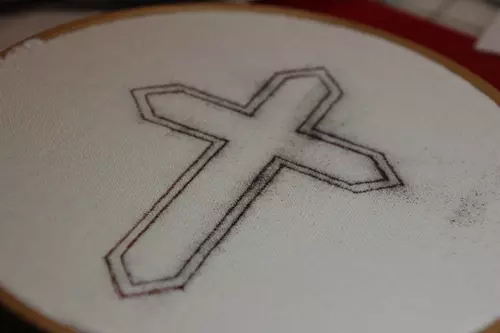
Creating Chalice Veil Cross in 20 minutes.
– The Design for the Chalice Veil Passion Cross is small. There was a tiny scrap of linen, washed and pressed, and with the right size, along with a piece of Kona Cotton to use as a backing. This was the perfect project for a small round hoop.
Like this:
Like Loading...

Looking for Ecclesiastical symbols? Check “Christian Symbols” for a book on Christian symbols and free PDF downloads. “Project Canterbury” has “Embroidery for Church Guilds” with simple designs. “Corpus Christi Watershed” archives complex Catholic Line Art. These resources inspire meaningful Ecclesiastical Embroidery projects.
Like this:
Like Loading...
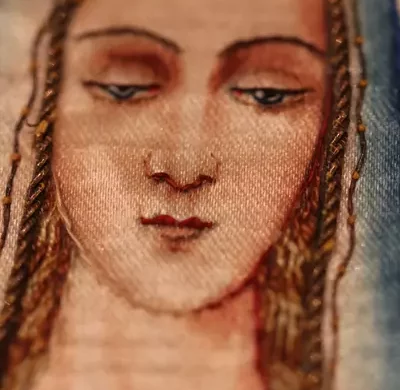
A trip to the Ursuline Center to explore interested items related to Ecclesiastical Embroidery and Vestments. The travel included stops at the Museum and the artist tower, and discovered a collection of hand-embroidered pieces and a few Ecclesiastical Banners that were hand-painted.
Like this:
Like Loading...

Ecclesiastical Sewing made a good progress on Embroidery project. Finished the background using Soie Ovale flat silk, giving it a smooth look. Managed those tricky silk strands with “The Best Laying Tool.” Now, onto the detailed goldwork Italian Stitch with Elizabethan Twist.
Like this:
Like Loading...
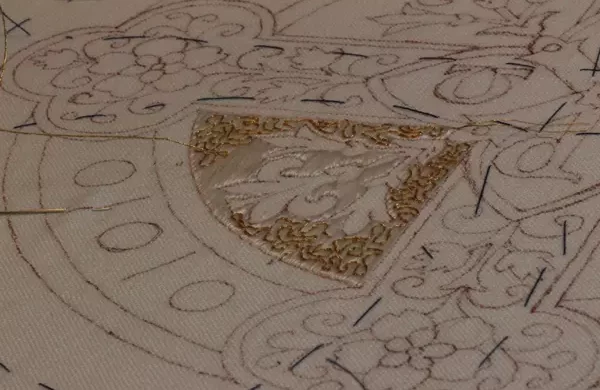
Progress on the Easter Set Pulpit Fall showcases intricate goldwork using Elizabethan Twist. The careful manipulation of the gold thread adds to the elegance. Soie Ovale silk thread in Creme complements the goldwork, and the laying tool aids in achieving a smooth finish. Balancing the gold thread and maintaining precision are ongoing challenges.
Like this:
Like Loading...
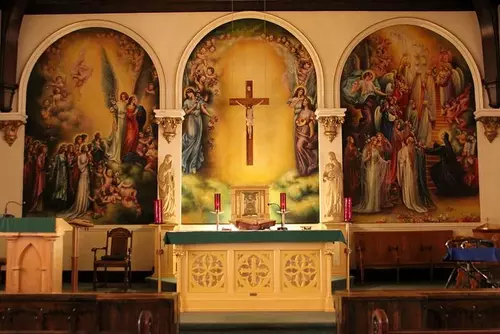
Summer travels brought unexpected surprises for the Ecclesiastical Sewing family in Montana. A visit to the Ursuline Center revealed a hidden treasure—a Sister’s art studio in the tower, showcasing two hand-painted Ecclesiastical Banners. One banner displayed signs of age with faded beauty, intricate details, and gold bullion fringe. The banners’ origin and age are unknown, making them even more intriguing.
Like this:
Like Loading...
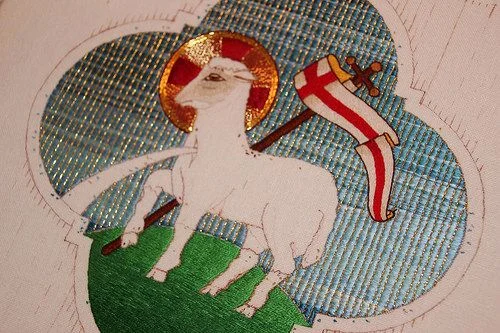
Making of the Littlest Lamb in The Tale of Two Lambs. Created on Alba Maxima linen from Hedgehog Handworks, this lamb comes to life with stitches and delicate shading. The linen provides a perfect canvas, and the project is stretched on an Evertite Frame. Various hand embroidery techniques, including long and short stitch shading, satin stitch, laid work, goldwork couching, split stitch, and stem stitch outlining, contribute to the lamb’s intricate details.
Like this:
Like Loading...
















You must be logged in to post a comment.